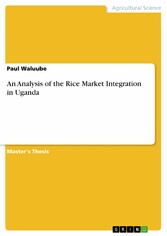Suchen und Finden
An Analysis of the Rice Market Integration in Uganda
Master's Thesis from the year 2009 in the subject Agrarian Studies, grade: 3.5, Makerere University (College of Agriculture & Environmental Sciences), course: Master of Science in Agribusiness Management, language: English, abstract: It is crucial that formulation of market enhancing policies to improve performance hinges on a better understanding of the local market functioning. Comprehensive market performance is better understood by studying the extent of spatial market integration which in turn is affected by communication factors like telephony growth and extension services within the marketing system. Extension services are important in influencing levels of production and dissemination of trade information of both the inputs to and output from the enterprise. Unfortunately very little was known about how rice price transmission takes place. Given the importance of rice (as a food security crop & source of income) to the rural poor, many organizations have promoted it among rural farmers for improving their welfare, it was imperative that its price movements is studied to inform policy makers & implementers on the status of its spatial market integration. The primary objective of this study was to evaluate the spatial market integration of rice markets under improving communication infrastructure particularly extension services (NAADS program) and telecommunication industry growth. This study specifically evaluated the degree of spatial market integration and strength of integration using bivariate analysis, Johansen Multiple test, and granger causality relationships. It also determined the impact of NAADS program and telecommunications on spatial rice market integration. Impulse response functions were generated to determine how long shocks in Kampala market can be eliminated in peripheral markets. Weekly prices data from sixteen markets from 2000 to 2006 were divided into three phases; full sample, pre - NAADS expansion and post NAADS program expansion to enable the study to capture the impact of these communication infrastructure. Results from this study indicate that the markets are spatially integrated and with an incredible speed over the study period. Comparatively, there was more co integration and interdependence of rice markets in the post-NAADS expansion phase than the pre - NAADS expansion phase. A further analysis of the markets using multivariate analytical approach revealed a growing rice economic market constituting eight markets; Kampala, Jinja, Iganga, Lira and Rakai including Gulu, Mbale and Soroti markets with which growth began in the pre-expansion period. [...]
Alle Preise verstehen sich inklusive der gesetzlichen MwSt.







